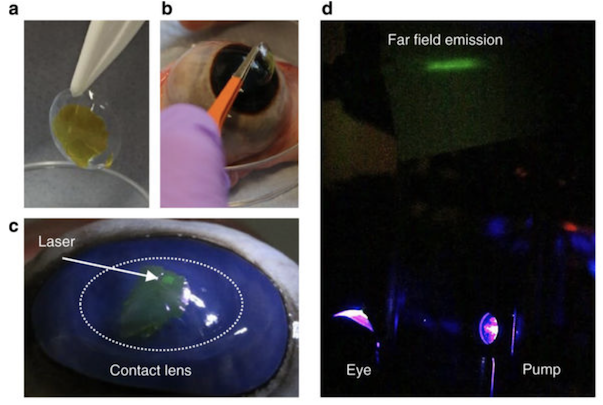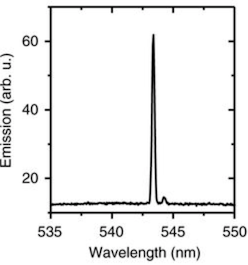Home
A comprehensive resource for safe and responsible laser use
Scotland: Scientists develop way to shoot laser light from eyes
The team from the University of St. Andrews demonstrated the new technology by putting a membrane laser onto a standard contact lens (photo a below), then placing this on a cow’s eye (photos b and c). A cow’s eye is similar to human eyes and is widely available as a byproduct of meat processing. The researchers then illuminated the eye with safe pulsed blue light (“Pump” in photo d) and “observed a well-defined green laser beam emerging from the eye” (“Far field emission” in photo d).

The diagram below shows the narrow wavelength of the emitted light (emission power on the left-hand scale is in “arbitrary units”).

The pump light minimum fluence to cause lasing was 58,800 W/cm², which is about one order of magnitude less than the maximum power density permitted by the ANSI 2000 standard for intentional and repeated ocular exposure. The researchers state that “a membrane laser on a contact lens could thus—under appropriate pumping conditions—be safely operated while being worn in the eye.”
Applications of the membrane laser include use as a security device affixed to banknotes or the human body (researchers also put a laser on a fingernail). A pumping beam is shone onto the substrate (banknote, eye, fingernail) to see if laser light of the expected wavelength is emitted. In the future, “[f]urther optimization of the DFB grating will likely allow lower lasing thresholds and facilitate LED pumping of membrane lasers. By combining recently developed roll-to-roll nanoimprint and organic ink jet printing technology, membrane lasers could be mass-produced with high reproducibility and at low cost.”
The researchers’ paper received widespread publicity, often with photos such as the one below. However, one of the authors, Prof. Malte Gather told the Express, “When we thought about this idea of making the laser membrane, someone suggested it was the first step towards making Superman real. It was meant as a joke but I thought it could be serious after all in certain applications. What is important for a normal human – not being Superman – is that our lasers are extremely efficient and hence can emit laser light that is not very bright. That excludes it from being used as a weapon but means that you could put it on to your eye without blinding yourself.”

From Nature Communications, volume 9, Article number: 1525 (2018), doi:10.1038/s41467-018-03874-w, available online here. Press release from University of St. Andrews. Typical popular press stories from U.S. News, USA Today, and the Express. A more detailed, science-oriented summary and discussion is from Optics and Photonics.